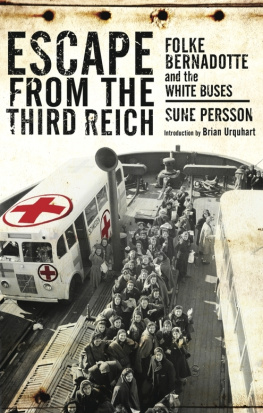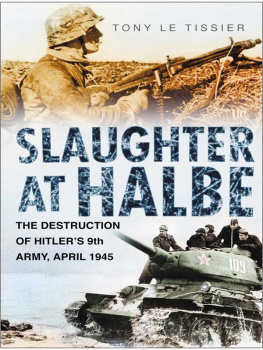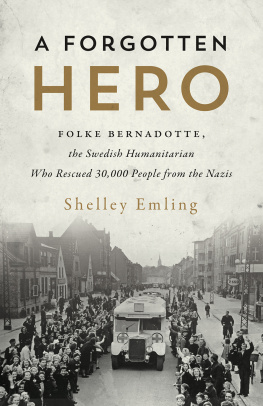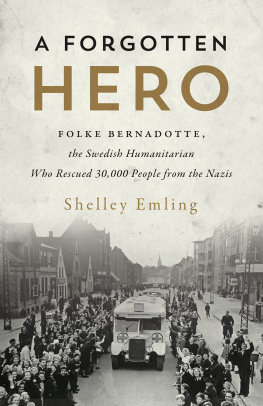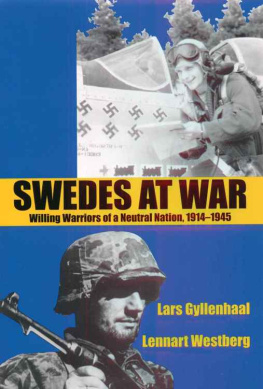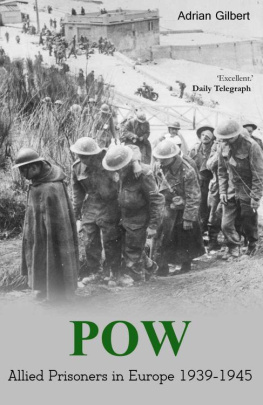This short biography is based on pp.225 7 of my dissertation Mediation & Assassination: Count Bernadottes Mission to Palestine in 1948 (London 1979). This includes a comprehensive list of books on Bernadotte, which were all published between 1945 and 1950 and were in the nature of tributes. Among them may be mentioned the British journalist Ralph Hewins Count Folke Bernadotte. His Life and Work (London 1950). Since then have appeared: the Israeli Amitzur Ilans malicious Bernadotte in Palestine, 1948. A Study in Contemporary Humanitarian Knight-Errantry (London 1989); the American journalist Kati Martons appreciative book A Death in Jerusalem (New York 1996); and a superficial biography in Swedish by Stig Hadenius, Vem var Folke Bernadotte? ( Who was Folke Bernadotte? ) (Lund 2007). The quote on p.7 is from Answers to Questions from Dr Amitzur Ilan, dictated by Estelle Ekstrand, December 1983; copy in Barbro Jerrings private archives. The 1943 visit to Geneva: Kristian Ottosen, Redningen. Veien ut av fangenskapet vren 1945 ( The Rescue: Emerging from Imprisonment Spring 1945 ) (Oslo 1998), p.92; the 1944 visits to London and Versailles are described in handwritten notes in the Count Folke Bernadotte archives, vol. 3 and 2, SRA. For relations between the International Committee of the Red Cross (ICRC) and the Swedish Red Cross (SRK), see Jean-Claude Favez, The Red Cross and the Holocaust (Cambridge 1999), pp.261, 278.
Norways Relations With Sweden During the War Years 1940 45 , Official documents published by the Norwegian Foreign Office, III, p.474 (reported in the Swedish evening newspaper Aftonbladet on 8 March 1945).
This short background sketch is based on the classic works by Alan Bullock, Hitler. A Study in Tyranny (rev. edn Harmondsworth 1962, 1st edn 1952) and by Joachim Fest, Hitler. Eine Biographie ( Hitler. A Biography ) (Berlin 1973). Still unsurpassed as an analysis of Hitler during the final stages of the war is H.R. Trevor-Roper, The Last Days of Hitler (rev. edn London 1973, 1st edn 1947); Hitlers will and testament here in facsimile, p.252.
The main sources here are Eugen Kogon, The SS State. The German Concentration Camp System (1st German edn 1947), Bullocks biography of Hitler as well as those of Himmler and Kaltenbrunner, i.e. Peter Padfield, Himmler. Reichsfhrer-SS (London 1990) and Peter R. Black, Ernst Kaltenbrunner. Ideological Soldier of the Third Reich (Princeton NJ 1984). Also relevant is Walter Schellenberg, The Labyrinth. The Memoirs of Hitlers Secret Service Chief (New York 1956). I have not however made use of these later notes but instead used Walter Schellenberg, Tagebuchskizze , his so-called Trosa Memorandum, completed at Trosa in Sweden prior to 9 June 1945. Trevor-Roper, in The Last Days of Hitler , is very critical of Schellenberg as a source yet makes abundant use of him. Undoubtedly Schellenberg after the war carefully minimised his own responsibility for the Nazis violent deeds while inflating his own excellence. Odder is the fact that Trevor-Roper in 1947 did not show the same scepticism towards Albert Speer as a source or, later during his feud with Bernadotte, concerning information from Felix Kersten (Himmlers masseur) or from Gottlob Berger (Himmlers chief of staff).
Five million Jews dead: Raul Hilberg, The Destruction of the European Jews (Chicago 1961), p.11; more than six million Jews dead: Stephane Bruchfeld & Paul A. Levine, Tell Ye Your Children... A Book About the Holocaust in Europe 1933 1945 (Stockholm 1998), p.2.
Communiqu issued by the chairman of the Jewish Community in Stockholm, Gunnar Josephson, and published by the Swedish Central News Agency on 25 and 26 January 1945. From the Jewish Community archives, IG 39:15, SRA.
Literature dealing with the Second World War and the Holocaust is now immense. The most important works on the Holocaust must still be the standard work by Hilberg, The Destruction of the European Jews and that of Yehuda Bauer, Jews for Sale? Nazi-Jewish Negotiations, 1933 1945 (New Haven 1994).
The main source of the subsequent short summary is Monty Noam Penkower, The Jews Were Expendable. Free World Diplomacy and the Holocaust (Urbana & Chicago 1983), particularly ch. 8 The World Jewish Congress Confronts the International Red Cross, pp.223 88, and ch. 9 The Sternbuchs, Storch, and the Reichsfhrer SS, pp.359 76.
The ICRC published a White Book after the war on its sharply criticised policies: Documents Relating to the Work of the International Committee of the Red Cross for the Benefit of Civilian Detainees in German Concentration Camps between 1939 and 1945 (Geneva 1975). The standard work is now Jean-Claude Favez, The Red Cross and the Holocaust (Cambridge 1995), see pp.260 72.
Regarding the War Refugee Board and Office of Strategic Services (OSS) in Sweden, see Meredith Hindley, Negotiating the Boundary of Unconditional Surrender: The War Refugee Board in Sweden and Nazi Proposals to Ransom Jews, 1944 1945, Holocaust and Genocide Studies , 10:1 (spring 1996), pp.52 77, and Wilhelm Agrell, Skuggor runt Wallenberg. Uppdrag i Ungern 1943 1945 ( Shadows Around Wallenberg. Assignment in Hungary 1943 1945 ) (Lund 2006).
The figures for those rescued in 1945 taken from Jewish Community minutes 1946, annual report 2 May 1946, Jewish Community archives (Stockholm), p.5. Inga Gottfarb, Den livsfarliga glmskan ( The Perils of Oblivion ) (Hgans 1986), pp.87 91. David Kpniwsky, Ngra ord och siffror om Mosaiska frsamlingens i Stockholm flyktinghjlp 1933 1950 ( A Few Words and Figures about the Assistance to Refugees by the Mosaic Community in Stockholm, 1933 1950 ) (Stockholm 1951), pp.1 64, stencil in Jewish Community archives, SRA, IG 36:13.
Storchs views on the Jewish Community from my interview with him: Stockholm, 27 July 1979.
Inga Gottfarb in letters to me: Stockholm, 29 September 2000, and Paris, 12 April 2001.
Miriam Nathanson, telephone conversation with me: Stockholm, 8 November 2000.
Jewish Community minutes, no.7, 15 May 1945, Jewish Community archives (Stockholm).
For details concerning Storch, see his case history in P1370 in the Swedish Security Police archives and in his own private archives, now housed at Central Zionist Archives (CZA), Jerusalem, under C4, World Jewish Congress, The Representative in Stockholm.
A young Swedish diplomat named Gran von Otter at the end of August 1942 was given a detailed description of the entire gas execution procedure by a German engineer Kurt Gerstein, who worked for the SS sanitary department. What subsequently happened with von Otters information is unclear. It was not until 23 July 1945 that von Otter in Helsinki wrote an aide-mmoire , which on 18 August 1945 was delivered to the British Foreign Office. The original copy of this memo is now in SRA, HP 1051. P.A. Levine, From Indifference to Activism (Uppsala 1996), pp.127ff., believed however that von Otters information somehow or other reached the Swedish Foreign Office as early as 1942.
Hindley, Negotiating the Boundary of Unconditional Surrender, pp.52 68; Penkower, The Jews Were Expendable , pp.268ff. Klaus, writing from a hospital, was to send increasingly bitter letters to Storch, claiming that it was he (Klaus) who had already taken the initiative in 1943 in liberating Jews from the German concentration camps; Klauss unanswered letters in CZA, C/591. Klaus had a Swedish deportation order pending when he died the night prior to the day he was to be deported (1 April 1946); official cause of death a heart attack. Kleist was extradited by Sweden on 27 August 1945 to the British zone in Germany. Bernadotte wrote a letter for Kleists benefit: He helped us in a splendid way by releasing thousands of Baltic subjects from the Baltic states to Sweden, Bernadotte to General Balfour, Stockholm, 14 September 1946, copy in SR A/SRK A/FBA. Fritz Hesse was arrested in Germany after the war and published his memoirs, Das Spiel um Deutschland ( Mnchen 1953) in which he described (pp.403 19) his secret talks in Stockholm between 19 January and 10 March 1945 with Jacob Wallenberg, Allan Vougt, Gilel Storch and Iver Olsen.

